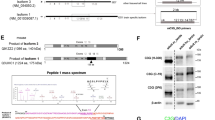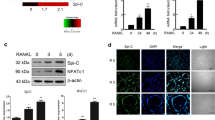Abstract
The intracellular mechanisms that determine the response of neural progenitor cells to growth factors and regulate their differentiation into either neurons or astrocytes remain unclear. We found that expression of SOCS2, an intracellular regulator of cytokine signaling, was restricted to mouse progenitor cells and neurons in response to leukemia inhibitory factor (LIF)-like cytokines. Progenitors lacking SOCS2 produced fewer neurons and more astrocytes in vitro, and Socs2−/− mice had fewer neurons and neurogenin-1 (Ngn1)-expressing cells in the developing cortex, whereas overexpression of SOCS2 increased neuronal differentiation. We also report that growth hormone inhibited Ngn1 expression and neuronal production, and this action was blocked by SOCS2 overexpression. These findings indicate that SOCS2 promotes neuronal differentiation by blocking growth hormone–mediated downregulation of Ngn1.
This is a preview of subscription content, access via your institution
Access options
Subscribe to this journal
Receive 12 print issues and online access
$209.00 per year
only $17.42 per issue
Buy this article
- Purchase on Springer Link
- Instant access to full article PDF
Prices may be subject to local taxes which are calculated during checkout






Similar content being viewed by others
References
Lee, J.E. et al. Conversion of Xenopus ectoderm into neurons by NeuroD, a basic helix-loop-helix protein. Science 268, 836–844 (1995).
Ma, Q., Kintner, C. & Anderson, D.J. Identification of neurogenin, a vertebrate neuronal determination gene. Cell 87, 43–52 (1996).
Cai, L., Morrow, E.M. & Cepko, C.L. Misexpression of basic helix-loop-helix genes in the murine cerebral cortex affects cell fate choices and neuronal survival. Development 127, 3021–3030 (2000).
Nieto, M., Schuurmans, C., Britz, O. & Guillemot, F. Neural bHLH genes control the neuronal versus glial fate decision in cortical progenitors. Neuron 29, 401–413 (2001).
Sun, Y. et al. Neurogenin promotes neurogenesis and inhibits glial differentiation by independent mechanisms. Cell 104, 365–376 (2001).
Bartlett, P.F. et al. Regulation of neural stem cell differentiation in the forebrain. Immunol. Cell. Biol. 76, 414–418 (1998).
Li, W., Cogswell, C.A. & LoTurco, J.J. Neuronal differentiation of precursors in the neocortical ventricular zone is triggered by BMP. J. Neurosci. 18, 8853–8862 (1998).
Johe, K.K., Hazel, T.G., Muller, T., Dugich-Djordjevic, M.M. & McKay, R.D. Single factors direct the differentiation of stem cells from the fetal and adult central nervous system. Genes Dev. 10, 3129–3140 (1996).
Williams, B.P. et al. A PDGF-regulated immediate early gene response initiates neuronal differentiation in ventricular zone progenitor cells. Neuron 18, 553–562 (1997).
Richards, L.J. et al. Leukaemia inhibitory factor or related factors promote the differentiation of neuronal and astrocytic precursors within the developing murine spinal cord. Eur. J. Neurosci. 8, 291–299 (1996).
Bonni, A. et al. Regulation of gliogenesis in the central nervous system by the JAK-STAT signaling pathway. Science 278, 477–483 (1997).
Faux, C.H., Turnley, A.M., Epa, R., Cappai, R. & Bartlett, P.F. Interactions between fibroblast growth factors and Notch regulate neuronal differentiation. J. Neurosci. 21, 5587–5596 (2001).
Nakashima, K. et al. BMP2-mediated alteration in the developmental pathway of fetal mouse brain cells from neurogenesis to astrocytogenesis. Proc. Natl. Acad. Sci. USA 98, 5868–5873 (2001).
Solecki, D.J., Liu, X., Tomoda, T., Fang, Y. & Hatten, M.E. Activated notch2 signaling inhibits differentiation of cerebellar granule neuron precursors by maintaining proliferation. Neuron 31, 557–568 (2001).
Koblar, S.A. et al. Neural precursor differentiation into astrocytes requires signaling through the leukemia inhibitory factor receptor. Proc. Natl. Acad. Sci. USA 95, 3178–3181 (1998).
Rajan, P. & McKay, R.D. Multiple routes to astrocytic differentiation in the CNS. J. Neurosci. 18, 3620–3629 (1998).
Endo, T.A. et al. A new protein containing an SH2 domain that inhibits JAK kinases. Nature 387, 921–924 (1997).
Naka, T. et al. Structure and function of a new STAT-induced STAT inhibitor. Nature 387, 924–929 (1997).
Starr, R. et al. A family of cytokine-inducible inhibitors of signaling. Nature 387, 917–921 (1997).
Hilton, D.J. et al. Twenty proteins containing a C-terminal SOCS box form five structural classes. Proc. Natl. Acad. Sci. USA 95, 114–119 (1998).
Krebs, D.L. & Hilton, D.J. SOCS proteins: negative regulators of cytokine signaling. Stem Cells 19, 378–387 (2001).
Polizzotto, M.N., Bartlett, P.F. & Turnley, A.M. Expression of “suppressor of cytokine signaling” (SOCS) genes in the developing and adult mouse nervous system. J. Comp. Neurol. 423, 348–358 (2000).
Rietze, R.L. et al. Purification of a pluripotent neural stem cell from the adult mouse brain. Nature 412, 736–739 (2001).
Reynolds, B.A. & Weiss, S. Clonal and population analyses demonstrate that an EGF-responsive mammalian embryonic CNS precursor is a stem cell. Dev. Biol. 175, 1–13 (1996).
Metcalf, D. et al. Gigantism in mice lacking suppressor of cytokine signaling-2. Nature 405, 1069–1073 (2000).
Krulich, L., Dhariwal, A.P. & McCann, S.M. Stimulatory and inhibitory effects of purified hypothalamic extracts on growth hormone release from rat pituitary in vitro. Endocrinology 83, 783–790 (1968).
Hojvat, S., Baker, G., Kirsteins, L. & Lawrence, A.M. Growth hormone (GH) immunoreactivity in the rodent and primate CNS: distribution, characterization and presence posthypophysectomy. Brain Res. 239, 543–557 (1982).
Edens, A., Southard, J.N. & Talamantes, F. Mouse growth hormone-binding protein and growth hormone receptor transcripts are produced from a single gene by alternative splicing. Endocrinology 135, 2802–2805 (1994).
Lobie, P.E. et al. Localization and ontogeny of growth hormone receptor gene expression in the central nervous system. Brain Res. Dev. Brain Res. 74, 225–233 (1993).
Ram, P.A. & Waxman, D.J. SOCS/CIS protein inhibition of growth hormone-stimulated STAT5 signaling by multiple mechanisms. J. Biol. Chem. 274, 35553–35561 (1999).
Greenhalgh, C.J. et al. Growth enhancement in SOCS-2-deficient mice is dependent on STAT5b. Mol. Endocrinol. 16, 1394–1406 (2002).
Nicholson, S.E. et al. Mutational analyses of the SOCS proteins suggest a dual domain requirement but distinct mechanisms for inhibition of LIF and IL-6 signal transduction. EMBO J. 18, 375–385 (1999).
Hojvat, S. et al. Growth hormone (GH), thyroid-stimulating hormone (TSH), and luteinizing hormone (LH)-like peptides in the rodent brain: non-parallel ontogenetic development with pituitary counterparts. Brain Res. 256, 427–434 (1982).
Delfs, J., Robbins, R., Connolly, J.L., Dichter, M. & Reichlin, S. Somatostatin production by rat cerebral neurones in dissociated cell culture. Nature 283, 676–677 (1980).
Ram, P.A. & Waxman, D.J. Role of the cytokine-inducible SH2 protein CIS in desensitization of STAT5b signaling by continuous growth hormone. J. Biol. Chem. 275, 39487–39496 (2000).
Hansen, J.A., Lindberg, K., Hilton, D.J., Nielsen, J.H. & Billestrup, N. Mechanism of inhibition of growth hormone receptor signaling by suppressor of cytokine signaling proteins. Mol. Endocrinol. 13, 1832–1843 (1999).
Fode, C. et al. A role for neural determination genes in specifying the dorsoventral identity of telencephalic neurons. Genes Dev. 14, 67–80 (2000).
Murphy, M., Drago, J. & Bartlett, P.F. Fibroblast growth factor stimulates the proliferation and differentiation of neural precursor cells in vitro. J. Neurosci. Res. 25, 463–475 (1990).
Thomas, H.E., Dutton, R., Bartlett, P.F. & Kay, T.W. Interferon regulatory factor 1 is induced by interferon-gamma equally in neurons and glial cells. J. Neuroimmunol. 78, 132–137 (1997).
Mullen, R.J., Buck, C.R. & Smith, A.M. NeuN, a neuronal specific nuclear protein in vertebrates. Development 116, 201–211 (1992).
West, M.J., Slomianka, L. & Gundersen, H.J. Unbiased stereological estimation of the total number of neurons in thesubdivisions of the rat hippocampus using the optical fractionator. Anat. Rec. 231, 482–497 (1991).
Acknowledgements
We would like to thank A. Voss for advice with stereology and M. Ransome for technical assistance. This work was supported by the NH and MRC of Australia, the CRC for Cellular Growth Factors, the Australasian Spinal Research Trust, the Motor Neurone Disease Research Institute of Australia, ANZ Charitable Trusts, the Clive and Vera Ramaciotti Foundation for Biomedical Research and the BHP Community Trust.
Author information
Authors and Affiliations
Corresponding author
Ethics declarations
Competing interests
The authors declare no competing financial interests.
Rights and permissions
About this article
Cite this article
Turnley, A., Faux, C., Rietze, R. et al. Suppressor of cytokine signaling 2 regulates neuronal differentiation by inhibiting growth hormone signaling. Nat Neurosci 5, 1155–1162 (2002). https://doi.org/10.1038/nn954
Received:
Accepted:
Published:
Issue Date:
DOI: https://doi.org/10.1038/nn954
This article is cited by
-
Discovery of an exosite on the SOCS2-SH2 domain that enhances SH2 binding to phosphorylated ligands
Nature Communications (2021)
-
Transcriptional and Epigenetic Regulation in Injury-Mediated Neuronal Dendritic Plasticity
Neuroscience Bulletin (2017)
-
Suppressor of Cytokine Signalling 2 (SOCS2) Regulates Numbers of Mature Newborn Adult Hippocampal Neurons and Their Dendritic Spine Maturation
Cellular and Molecular Neurobiology (2017)
-
A novel ligand of calcitonin receptor reveals a potential new sensor that modulates programmed cell death
Cell Death Discovery (2016)
-
RETRACTED ARTICLE: Expression of SOCS2 mRNA and protein in the ischemic core and penumbra after transient focal cerebral ischemia in rats
Cell and Tissue Research (2016)



